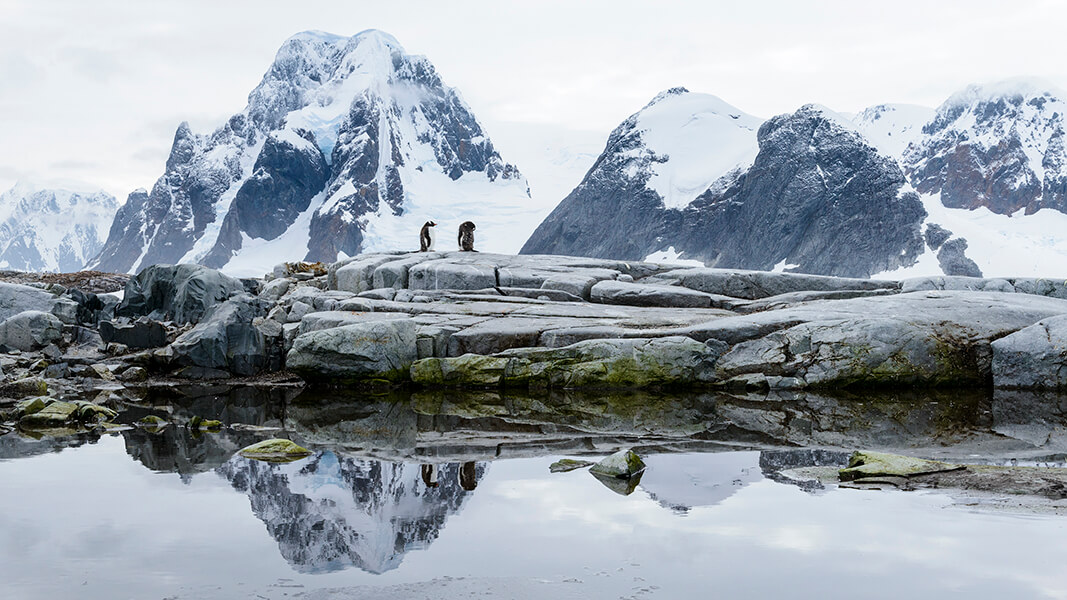
Destination Antarctica Part 2: Is a Cruise to Antarctica For You?
(This is the second installment of our two-part interview of Anita Root’s adventures in Antarctica. To read more about the wildlife, the scenery, and the expeditions available on an Antarctica cruise, visit Destination Antarctica Part 1: Our Cruise Report from the Seventh Continent.)
________________________________________________
So here’s what everybody wants to know about Antarctica: what about the cold?
A: Everyone thinks Antarctica is cold all the time, that it’s going to be colder than you can possibly stand. But there are two distinct seasons, just summer and winter, and summer runs October through February. So, when we’re in our winter [in North America], it’s really not that cold in Antarctica.
We’re colder here [in Minnesota] today than Antarctica!
A: That’s exactly what I was thinking. The temperature here today [1/20/2019] is -7°F and there it’s 34°F.
The summer months have an average temperature between 29°F and 40°F. And that’s the right temperature to get some snow so that everything is pretty and pristine looking.
I think as a traveler you have to be prepared for the temperature. If you bring the right gear, you’re already assured you’re going to have a great day. You don’t want to get cold, you want to be out there enjoying it as long as you can. If you bring the right gear, you won’t get cold.
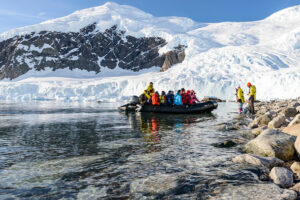
Zodiac landing
What gear did you bring? I hear we’re providing jackets for our Go Next travelers to keep…?
A: The jacket is a 3-in-1. It’s really like two jackets and you could wear either one by itself or both of them together when you go ashore. It’s a quilted jacket underneath and a waterproof and windproof shell on the outside.
The complimentary boots [provided for guest use on the ship] are rubber and they’re insulated. That’s what you use when you go ashore and onto the Zodiacs. And you just have to bring warm socks. That’s all I wore, a pair of wool socks and my feet were warm.
So you’ve been on so many trips, researching products for our guests—how would you describe the Antarctica cruise compared to a typical cruise? How was it the same or different?
A: When I think about what our guests want, they are experienced travelers, for the most part. They’ve been to six continents, they’re looking for opportunities to see the seventh continent. So I think it’s best to compare to how it doesn’t compare to a luxury cruise. There’s no assigned seating, no elaborate onboard shows, and no formal dinners. You need room to pack your outer gear, not your formal attire.
On most cruises you have to select your shore excursions in advance and most come with an additional cost. With the exception of those that want to kayak, the landings and Zodiac excursions are all included because that is the whole purpose of the journey.
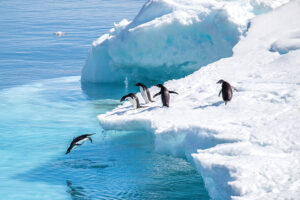
Penguins, Antarctica
So who do you think this trip will appeal to?
A: You’re joining others who also have a sense of adventure, so it’s so much fun to talk to other people who are a lot like you. And going to this location—more remote, not everybody does it—I think it’s more authentic if you’re on this type of ship, an expedition ship. It feels like this ship belongs there.
On a typical cruise, usually day by day you know where you’re going to be. You know what excursions you’re going to take. [In Antarctica] you don’t pick the excursions. Depending on the environment and the day, the excursion picks you. It’s where you can go that day because of the environment. But the crew has done this so many times they decide that, for example, “[if we can’t see what we planned], we can go around this little area, it has a little cove that is not as windy.” And it ends up a better place to see wildlife. It’s just being able do whatever is presented to you that day. It picks you. Where Mother Nature will allow you to go, to land.
Of course, everyone will want to know how the amenities compare to a typical cruise. Let’s start with: how is the food?
A: There was no shortage of food, there was a great abundance at all times!
The format for breakfast and lunch are both buffet style. You have the typical American breakfast options: eggs, meat, potatoes …and also European breakfast breads and cheeses. Also fruits, cereals, yogurt, muesli. The whole range, so you can eat really healthy one day and maybe the next day you want to indulge a bit.
For lunch it’s entrées, soups, salads, desserts. And if the seas are particularly rough, the servers help bring your food back to your table.
At dinner, it’s generally à la carte. They give you a menu with several entrée options. You get an appetizer, soup or salad, an entrée, and then dessert. You can choose one or more if you want. Some people made their own surf and turf and some wanted to eat a bit lighter with a double salad.
They have an early riser breakfast set up by the library with juices and pastries just in case you want to snack before regular breakfast. And in the afternoon when everybody comes back from their excursions, you’re famished. So they have teas, coffees, water, and also finger sandwiches, some savory and some sweet, just some snacks to get you through the afternoon. Those were quite nice, too.
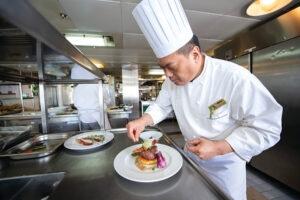
Chef aboard Ocean Atlantic
And what is a cabin like on an expedition-style ship?
A: I’ll tell you first how I think it’s similar to your typical cruise ship. Everyone has an in-room bathroom, very modern with all of the amenities. Most of the rooms are set up as two twin beds, but some can be configured (either a double or two twin beds). They have TVs with movies, a reading light, an in-room safe—so many things are the same. It’s like a hotel. Only two cabin category types are inside only. Other than that, every room is a room with a view. I had a B category cabin with three large windows that I could see out.
There is a fair amount of storage, but it’s not endless. But that’s what makes the mudroom on the ship so unique: you don’t have to bring your very bulky and maybe wet expedition gear into your room to hang out to dry. The mudroom allows you a lot of flexibility to store [your gear] out of your room.
The TV in your room also doubles as your agenda. Maybe it has photos of what someone saw yesterday, but then it also has the agenda so you don’t have a lot of paper in your room.
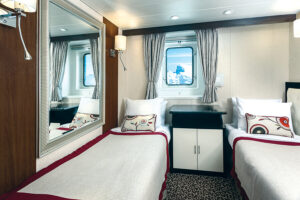
Ocean Atlantic – Category C Cabin
Tell us about what did in any down-time you had. There are obviously no Vegas-style acts on a ship like this—
A: Between the eating, the excursions, and the lectures, that’s when you have your down time.
The Viking Lounge is where you sit and make new friends. You talk with them, maybe show the pictures that you took or talk about what you’re going to see tomorrow or where you’ve traveled before—because these people are world travelers. Each night they have a special drink of the day—and now I know I like Brandy Alexanders, so that was kind of fun. The bartenders are very friendly, and they learn what you like.
There was trivia one night based on all of the lectures. And we thought we would do better on the trivia if we brought the ornithologist with us, so we annexed him. And then we didn’t do that well!
It sounds like you get to know the expedition crew pretty well.
A: The expedition crew is mingling the whole time. We asked them to come sit with us because we had some more questions. I didn’t want to monopolize the lecture, but I had five more questions that came up. You can invite them to have dinner with you. It’s interesting to find out what brings them to this place that becomes their life’s work.
On one of the [Drake Passage] crossing days they had a cooking demonstration. There are a fair amount of Asian staff, so they were teaching us how to make Chinese dumplings. Someone from one of the Russian expedition teams came in, and he’s like, “I’ll show you how to make a dumpling! This is how Russians make dumplings!” Then it became a bit of a competition. The Russian dumplings were much easier to make than the Chinese dumplings.
In down time they might have a yoga class—or one time, the cabin crew showed us how to make all of the towel animals—that was a lot of fun, too.
What did you think about the activity level for the actual expeditions? How physically taxing would you say the outings were?
A: There is a modest amount of walking, not long distances by any means. It could be snowy. It could be uneven, but no vertical ascents.
For people who want more activity they could do kayaking. You usually have a guide with you to tell you what areas you can go to. There are areas where there may be nestings you want to avoid.
In your pictures you can see that the Zodiacs put you right in the water and brought you close to the animals—it looked a little bit scary.
A: The first time you get into the Zodiac you might be a little apprehensive. Maybe you’re not sure how stable the ship is or how stable you are. But you learn what they call the shoreman’s grip…you grab the forearm of staff and they in turn grab your forearm—very sturdy grip as they guide you into the Zodiac. Then you have to make three steps to get on. You step on to the Zodiac, then onto a one-rung wooden step, and then onto the bottom of the Zodiac. You pivot and sit down. And when one guy lets go of your arm as you step onto the Zodiac, the driver helps you again and sits you down before the next person gets in. Unless you do a running jump you won’t have any problem. It’s very stable getting in.
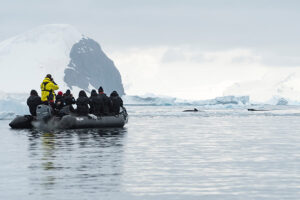
Zodiac excursion
Now that you have seen the ship, crew, scientists, animals, icebergs, give us tips about how to visit the Antarctic “the right way.”
A: I think you should have as much time behind your camera as not behind your camera. Make sure that you are not just seeing [Antarctica] through a small little lens all of the time if you want to really experience it.
And be quiet. A couple of times our entire Zodiac was like, “let’s just not talk for a while,” just so we could sit there and look at it all. It’s emotional because it’s so beautiful and so quiet.
Go in with an idea of an exploration of your own—a place you’ve never been. Don’t have too many preconceived ideas. If you don’t get to stop at one place you’ve heard of, the place you go instead will be equally undisturbed and fascinating. The reason you’re going is to experience things that you couldn’t even imagine.
So, just be in the moment?
A: Yes.
The one thing that got me several times on this trip is that you’re on a significant ship that’s big and can make its way through these waters. When you think about explorers who did this not knowing what’s at the other end, not having modern ways of knowing what wind is ahead, what weather is ahead, no one can call you and tell you something bad is coming—you just realize how tough they were. The area is unforgiving if you make mistakes. They did it not knowing what was going to happen.
This ship has a lot of comfort—comfortable cabins, nice airy spaces, a nice variety of food, cocktails, and hot beverages to warm you up when you come back inside. A lot of comfort that none of those explorers had. But it offers the right experience when you want to get near some of these places.
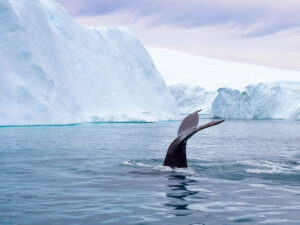
Whale fluke
So comfort, adventure, a little bit of both.
A: Right. And it’s not over the top. You don’t have fancy dress codes and assigned seating. If you want to sit with the expedition crew, invite them in and ask them how many times they’ve been to Antarctica and listen to some of their stories.
Any last thoughts you want our readers to understand about your trip?
A: So how many people a year go to Antarctica? It’s maybe 35,000 people a year. And I thought hmm, how many are going to be at the Super Bowl? Probably about 70,000. And so the number of people who go to Antarctica in a year, you could double that and that’s who would sit in the Mercedes Benz stadium. So that puts it in context, that it’s not for everyone. But it’s probably for someone who wants to get to the seventh continent to get it off their bucket list.